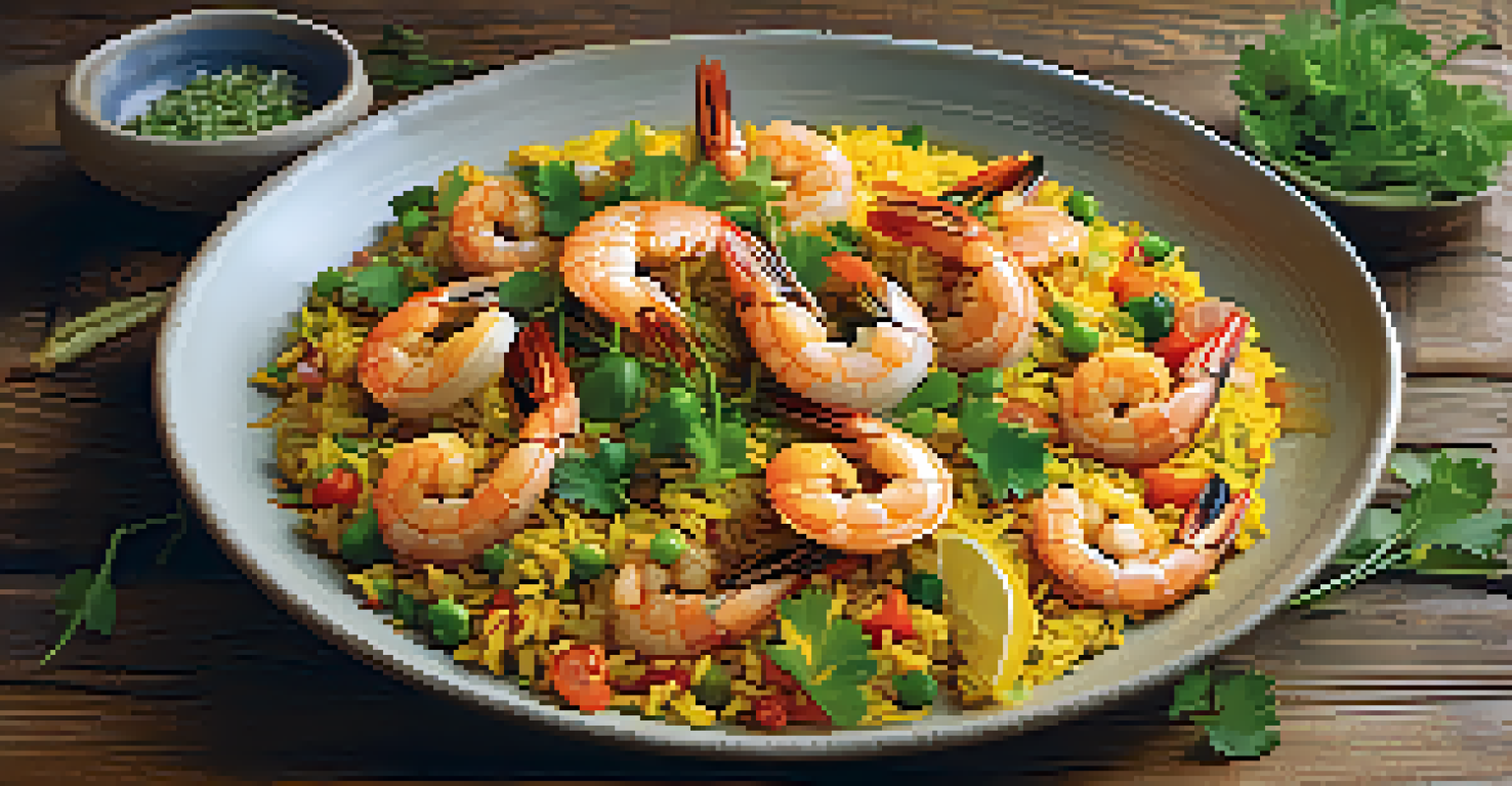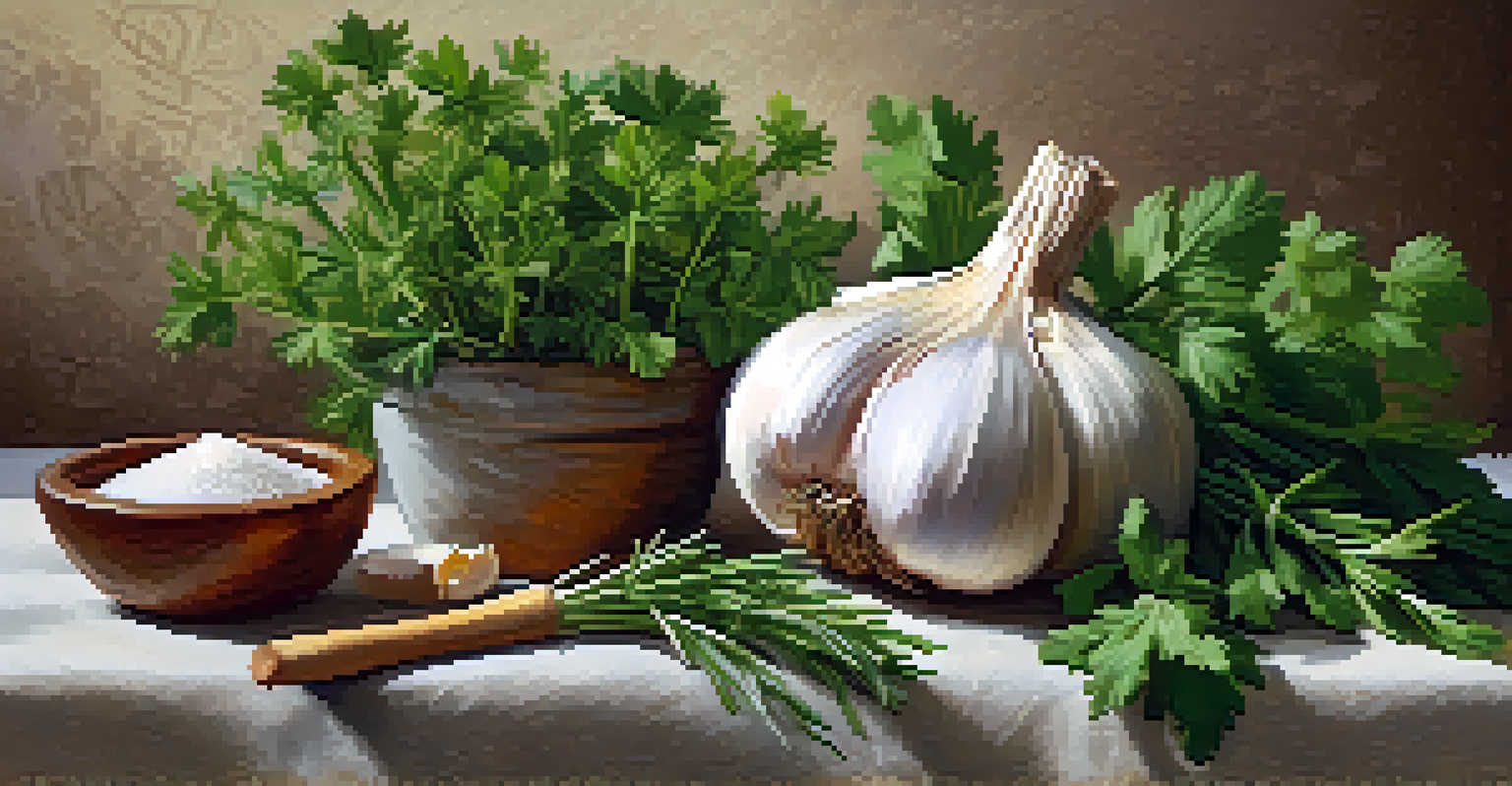Culinary Herbalism: The Healing Properties of Spanish Herbs

Introduction to Culinary Herbalism and Its Benefits
Culinary herbalism is the art of using herbs not just for flavor but for their healing properties. It combines cooking with herbal medicine, allowing us to enhance our meals while promoting wellness. Spanish herbs, in particular, are rich in history and tradition, often used in both cuisines and remedies.
Herbs are the friend of the physician and the pride of cooks.
Integrating these herbs into our daily diets can offer a variety of health benefits, from boosting immunity to aiding digestion. Think of it as a delicious way to nurture your body. By understanding the healing properties of specific herbs, we can make more informed choices about what we eat.
Imagine sprinkling some fresh oregano on your pasta, not just for taste, but also for its antioxidant properties. Each herb tells a story, connecting us to centuries of culinary practices that prioritize health and flavor.
The Versatile Benefits of Oregano in Spanish Cuisine
Oregano is a staple in Spanish cooking, known for its robust flavor and impressive health benefits. This herb is packed with antioxidants, which help combat oxidative stress in the body. It's often used in dishes like paella and tapas, enhancing both taste and nutrition.

Beyond its culinary uses, oregano has been traditionally used to support respiratory health. Its antimicrobial properties can help fend off colds and infections, making it a go-to herb during flu season. Adding a sprinkle of dried oregano to your meals could be a simple yet effective way to boost your health.
Culinary Herbalism Enhances Meals
Integrating herbs like oregano and thyme into cooking not only boosts flavor but also provides health benefits.
Picture enjoying a warm bowl of Spanish stew, enriched with oregano, knowing you’re not just savoring the flavor but also nurturing your body. This dual purpose is at the heart of culinary herbalism.
Thyme: An Aromatic Herb with Healing Qualities
Thyme is another powerful herb commonly found in Spanish kitchens, celebrated for its aromatic qualities and healing benefits. Rich in vitamins C and A, thyme supports the immune system and promotes overall health. It’s often used in marinades and sauces, adding depth and character to a variety of dishes.
Let food be thy medicine and medicine be thy food.
Additionally, thyme has been shown to possess antimicrobial properties, making it a great ally in fighting infections. Its essential oils can even aid in respiratory issues, providing relief from coughs and congestion. Incorporating thyme into your meals can enhance both flavor and wellness.
Imagine infusing a hearty dish with thyme, not just enjoying its savory notes but also reaping its health benefits. This is the essence of culinary herbalism—transforming everyday meals into health-boosting experiences.
Rosemary: A Herb for Memory and Digestion
Rosemary is a fragrant herb that’s not only popular in Spanish cooking but is also linked to improved memory and digestion. Often used in roasted meats and vegetables, rosemary adds a unique flavor that can elevate any dish. Its distinct aroma has been associated with cognitive benefits, helping to improve concentration.
Moreover, rosemary is known for its digestive properties, often used to relieve bloating and discomfort. Using rosemary in your cooking can be a way to enjoy flavorful meals while also caring for your gut health. It’s a simple addition that can make a significant impact.
Spanish Herbs Promote Wellness
Herbs such as rosemary and saffron contribute to improved memory, digestion, and mood, enriching our overall health.
Picture a roast infused with rosemary—its earthy flavor and health benefits working together to create a delightful dining experience. Culinary herbalism invites us to savor the healing aspects of our food.
Saffron: The Golden Spice with Healing Properties
Saffron, often hailed as the most expensive spice in the world, is a gem in Spanish cuisine, particularly in dishes like paella. This vibrant herb isn't just about luxury; it offers numerous health benefits, including mood enhancement and antioxidant properties. Saffron has been linked to reducing symptoms of depression and anxiety, making it a valuable addition to your pantry.
Additionally, saffron may help improve digestion and reduce inflammation in the body. Including this golden spice in your meals can turn an ordinary dish into a therapeutic experience. Its rich flavor and health benefits make saffron a true culinary treasure.
Imagine the warmth of saffron-infused rice, not only pleasing to the palate but also uplifting your spirits. This is the magic of culinary herbalism, transforming everyday ingredients into powerful allies in our health journey.
Garlic: A Flavorful Ally for Heart Health
Garlic is a beloved ingredient in Spanish cuisine, known for its bold flavor and incredible health benefits. It’s celebrated for its ability to support heart health by lowering cholesterol and blood pressure levels. Garlic contains compounds like allicin, which have been shown to have anti-inflammatory effects.
Incorporating garlic into your meals can enhance flavor while promoting cardiovascular health. Whether in a traditional garlic shrimp dish or blended into a sauce, this herb is a powerhouse of flavor and wellness. It’s a reminder that the simplest ingredients can offer profound benefits.
Mindful Eating with Herbs
Embracing culinary herbalism encourages a conscious approach to meals, where every ingredient serves a purpose beyond taste.
Visualize a warm, garlicky dish, knowing that with each bite, you’re not just enjoying a taste sensation but also caring for your heart. This blend of culinary enjoyment and health is the essence of culinary herbalism.
The Role of Cilantro in Detoxification
Cilantro, or coriander, is a fresh herb that adds a bright flavor to many Spanish dishes, especially salsas and salads. Beyond its culinary appeal, cilantro is known for its detoxifying properties, helping to eliminate heavy metals and toxins from the body. This makes it a valuable herb for anyone looking to enhance their overall health.
Cilantro is also rich in antioxidants and has been linked to improved digestion. Its vibrant flavor can transform a simple dish into something extraordinary, all while contributing to your detox efforts. Adding cilantro to your meals can be a refreshing way to support your body's natural cleansing processes.

Imagine digging into a fresh salsa brimming with cilantro, not just enjoying its zesty taste but also giving your body a gentle cleanse. Culinary herbalism allows us to appreciate such dual benefits in our food.
Embracing Culinary Herbalism in Everyday Life
Embracing culinary herbalism means recognizing the power of herbs in our daily meals. By incorporating Spanish herbs into our cooking, we can not only enhance flavor but also promote our health. It encourages a mindful approach to eating, where every ingredient serves a purpose beyond taste.
Start by experimenting with different herbs in your favorite recipes. Whether it's adding a pinch of thyme to a soup or topping a salad with fresh cilantro, small changes can lead to significant benefits. This journey into culinary herbalism is about discovering how our food choices impact our well-being.
Ultimately, culinary herbalism invites us to create a connection between our meals and our health. By incorporating these vibrant Spanish herbs, we can nourish our bodies while enjoying the rich tapestry of flavors they offer.